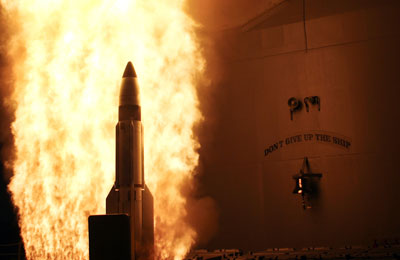Space control in the Air Force’s 2014 budget requestby Victoria Samson
|
| Unless there are other projects tucked away in the classified portion of the US Air Force’s budget request, it does not appear that the United States is undertaking any new anti-satellite or offensive counterspace effort. |
First, it helps to understand how the US Air Force defines space control. According to the budget justification documents released as part of the request, space control’s mission area is comprised of “Space Situational Awareness (SSA), Defensive Counterspace (DCS), Offensive Counterspace (OCS) and Command and Control (C2) and Battle Management.” 3 This is not new, as it echoes language from previous years’ budget justification documents.
However, it does contradict guidance given in the most recent (May 2013) Joint Space Operations guidance document. Space control, according to this document, consists of:
“offensive space control (OSC) and defensive space control (DSC). OSC are measures taken to prevent an adversary’s hostile use of US/third-party space capabilities or offensive operations to negate an adversary’s space capabilities used to interfere with or attack US/allied space systems. DSC are operations conducted to preserve the ability to exploit space capabilities via active and passive actions, while protecting friendly space capabilities from attack, interference, or unintentional hazards.” 4
SSA, on the other hand, is promoted to the fifth space mission area, and explained as “characterizing, as completely as necessary, the space capabilities operating within the terrestrial environment and the space domain.” 5
Examining the counterspace budget line, it is very similar to what is has been in the past; in fact, the amount requested is less than what was asked for last year. In FY 13, the Air Force requested $28.8 million for the total program element; in FY 14, it asked for $23.9 million. 6 The counterspace budget line also has the same major sub-elements as it has had in previous years. First, there is the “jamming” program, known as the “Counter Satellite Communications System,” which strives for the “development of mobile/transportable counter satellite communications capabilities in the area of Offensive Counterspace,” intended to develop “capabilities to provide disruption of satellite communications signals in response to USSTRATCOM requirements.” 7 Then there is Rapid Identification Detection and Reporting System (RAIDRS), which detects jamming of US or allied satellites and “is focused on detecting, characterizing, geolocating and reporting satellite communications (SATCOM) radio frequency interference (RFI) using currently existing Commercial-Off-the-Shelf (COTS) and Government-Off-the-Shelf (GOTS) technology.” 8 Finally, there is Offensive Counterspace (OCS), which “supports the development of command and control and mission planning capabilities in support of the fielding and employment of Counterspace Systems.”9 This funding line is for manpower and operations, not for any sort of weapon system.
Looking at the Space Protection Program, there is an increase from the FY 13 budget request of $10.4 million to the FY 14 request of $28.8 million. 10 Most of that increase can be traced to the creation of a new project called “SATCOM [Satellite Communication] Resiliency Enhancement,” which, at $10 million, is a four-year effort “to upgrade the ground-based software used to plan Satellite Communications (SATCOM) operations.” 11 Also new in FY 14 is the $3.6 million “Strategic Protection Activities and Product,” which covers efforts “to evaluate architectures, develop and support protection-related policy, influence and integrate protection requirements, and conduct long term threat assessments and evaluations.” 12
| Carter’s statement might have been deliberately constructed to send a message; furthermore, one could debate how these projects are perceived internationally. |
The program element of Space Situational Awareness Systems saw an increase in the amount requested for it, from $267.3 million in FY 13 to $400.3 million in FY 14. 13 New this year is the $8.5 million to move an existing C-Band radar from Antigua to Australia to improve SSA, per a 2012 memorandum of understanding signed between the United States and Australia. 14 Also, there is a sizable increase in funding requested for the Space Fence (from $252.6 million in FY 13 to $377.7 million in FY 14, most likely in anticipation of the contract award to commence building the system). 15 The rest of it appears to be fairly constant from last year’s request.
To summarize, Carter’s statement implying that the United States is working on a new ASAT program is not borne out when the 2014 budget request is examined. His statement might have been deliberately constructed to send a message; furthermore, one could debate how these projects are perceived internationally. But in any case, it does not appear that the United States has launched any new ASAT or offensive counterspace programs this year.
References
1 Andrea Shalal-Esa, “Pentagon Cites New Drive to Develop Anti-Satellite Weapons,” Reuters, May 8, 2013.
2 Ibid
3 Department of Defense Fiscal Year (FY) 2014 President’s Budget Submission, Air Force Justification Book Volume 2 of 3, Research, Development, Test & Evaluation Air Force, April 2013, p. 77.
4 Joint Publication 3-14, Space Operations, May 29, 2013, p. xi
5 Ibid, p. x
6 Department of Defense Fiscal Year (FY) 2014 President’s Budget Submission, Air Force Justification Book Volume 2 of 3, Research, Development, Test & Evaluation, Air Force, April 2013, p. 477
7 Ibid, p. 479
8 Ibid, p. 485
9 Ibid, p. 491
10 Ibid, p. 127
11 Ibid, p. 128
12 Ibid, p. 130
13 Ibid, p. 497
14 Ibid, p. 518
15 Ibid, p. 505
